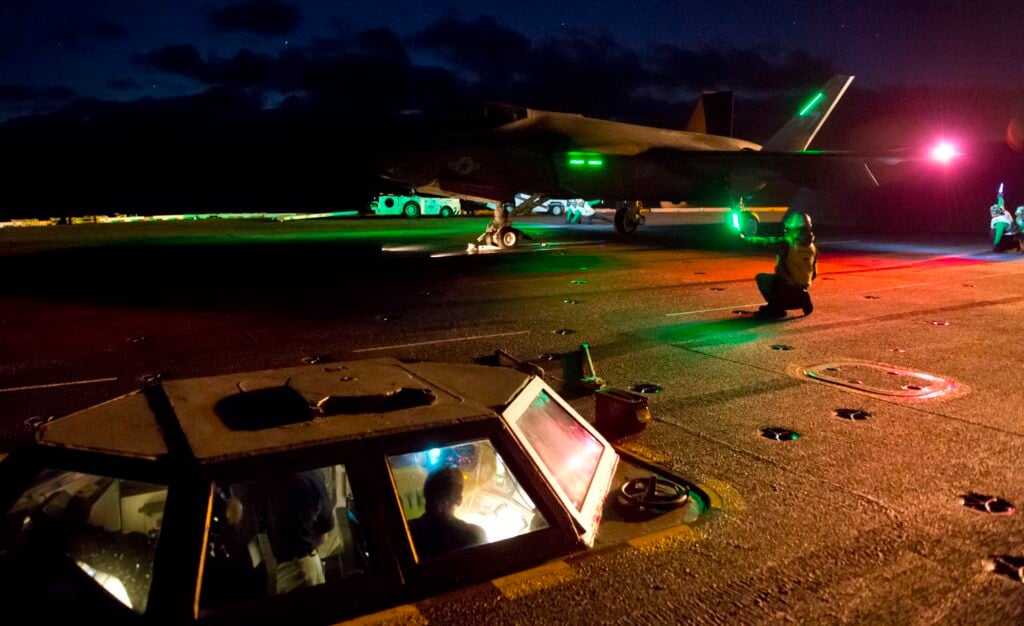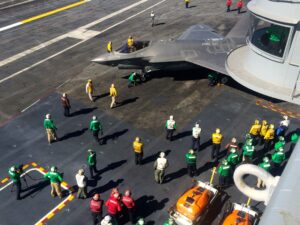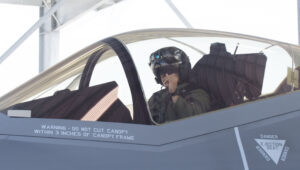JPO Fixing F-35 Oxygen, Carrier Landing, Software Glitches: VADM Winter
Posted on

F-35C night takeoff from USS Nimitz
CORRECTED number of hypoxia incidents ARLINGTON: As the F-35 prepares for a massive ramp-up in production, the program is fixing the costly, controversial plane’s last technical glitches, Vice Adm. Mat Winter said in his first press conference since becoming program director. Winter expressed confidence about three problems in particular: air supply for pilots, carrier landings, and – the 800-pound gorilla of the F-35 program – software.
The issue with air supply is simple: Are pilots getting the right amount of oxygen, at the right pressure, without contaminants? Getting dizzy in a fighter cockpit, let alone passing out, is a recipe for disaster.

Vice Adm. Mat Winter
CORRECTED F-35 pilots have reported 27 “physiological episodes” since 2011 – 22 of them in the air and five on the ground – with a recent rash of six incidents at Luke Air Force Base. Painstaking investigations are still underway, looking at the state of the aircraft, pilot, and environmental conditions in every incident, but there seem to be two causes, both solvable.
First, the cockpit warning light for the On-Board Oxygen Generation System (OBOGS) goes off too often, making pilots think they had a problem with their air supply when there really wasn’t one, Winter said at the DefenseNews conference here yesterday. Since the warning signs of hypoxia are the same as the signs of getting anxious about hypoxia – you have trouble breathing and concentrating – a false alarm can easily send a pilot into psychosomatic symptoms. The program has tweaked the warning light to reduce false positives, Winter said. It’s also improving filtration and pressure.
Second, in this summer’s incidents at Luke in particular, the problem was a combination of brutal temperatures and inexperienced pilots. While pilots who know an aircraft well can jump in the cockpit, run through their checklists, and get in the air ASAP, the F-35 is a new plane and most of its pilots are still mastering it. The result was pilots spending half an hour on the runway in the baking Arizona sun and 100-plus degree heat, all the while sitting in the carbon monoxide from their own jet exhaust. That’s enough to make anyone woozy. Fixing this problem requires new training and procedures rather than modifications to the aircraft.

While Air Force pilots were baking in the desert, Navy pilots were shaking at sea. Catapult launches off the deck of an aircraft carrier are hard on any aircraft ,but F-35C pilots were shaking so hard they couldn’t see or reach key controls, sometimes even banging their high-tech helmets on the canopy. Pilots also complained the cockpit displays were too bright, creating so much “green glow” in their night-vision systems that they couldn’t always see clearly during night landings on the carrier – an operation traditionally considered even more stressful than combat.
The program’s adjusted the helmet display, Winter said. It’s also retrained pilots and made minor adjustments to fix the intense vibration during catapult take-offs (“cat stroke”). There’s no need for a costly and time-consuming redesign of the aircraft’s nose landing gear, as some had thought.
Two Navy F-35C squadrons (VFA-101 and VFA-125) now have both sets of fixes and are going through carrier qualifications with them aboard the USS Abraham Lincoln, Winter said. This isn’t a test specially arranged for the F-35 program, he emphasized. It’s pilots going through their routine training, using the improved gear and providing feedback on it.

An Air Force pilot, Lt. Col. Chris Pitts, in the cockpit of his F-35A.
Whether on the sea, on land, or in the air, software underlies everything the F-35 does. While both the Marines and Air Force have declared their F-35s Initially Operationally Capable (IOC), the plane won’t be fully capable until it gets a software update designated Block 3F. “We are meeting or exceeding all the warfighers’ ORD (Operational Requirements Documents) requirements right now” for the 3F software, Winter said. That 3F software is already going on aircraft coming off the Lockheed Martin assembly line in Fort Worth, Texas, Winter said. It’s not the absolute final version of 3F, he acknowledged, because additional testing must be done before the software is fully “verified and validated.” The program is already compiling a database of deficiencies it must correct, he said. Most of them are minor issues, such as indicators moving too much on displays or radar screen refresh rates being a few seconds too slow.
Flight testing of Block III will be done “by the end of this calendar year,” Winter said, which is well ahead of where the program expected to be this time last year. Operational testing – run by the Pentagon’s notoriously tough and independent Director of Operational Test & Evaluation – will start in February. Winter doesn’t expect DOT&E to find new software problems, but the program stands ready to fix 3F if necessary.
After Block 3F will come Block 4, a package of future upgrades whose content and schedule are still being defined. Winter said he’s taking a “strategic pause” to reassess how to move to Block 4. In the near term, he wants to smooth the transition between blocks, with work on 3F fixes overlapping with development of Block 4’s new features. His ultimate goal is a flexible process that accepts software upgrades from a wide variety of vendors – without the laborious process of issuing new contracts every time – and then transmits the upgrades automatically across the fleet, the way Apple pushes out new iPhone software.
 All this work to fine-tune the technology of the F-35 lays the groundwork for full-rate production. Winter is asking Congress to approval a block buy arrangement under which the program could order key components two years in advance instead of the normal 12 months, which would reduce costs by buying in bulk. Lockheed Martin currently builds 60 F-35s a year (five a month) for both US and foreign customers. That’s already a higher rate than most defense programs in this cash-strapped era, but the goal is to more than quadruple production to 260 a year (between 21 and 22 a month). The number of F-35s in service requiring spare parts, software upgrades, repairs, and other ground support will go from 250 to almost 1,000 within five years. By that point, the F-35 program needs to have fixed all the airplanes’ teething troubles so it can concentrate on the massive industrial challenge of building and sustaining almost 2,500 aircraft around the world.
All this work to fine-tune the technology of the F-35 lays the groundwork for full-rate production. Winter is asking Congress to approval a block buy arrangement under which the program could order key components two years in advance instead of the normal 12 months, which would reduce costs by buying in bulk. Lockheed Martin currently builds 60 F-35s a year (five a month) for both US and foreign customers. That’s already a higher rate than most defense programs in this cash-strapped era, but the goal is to more than quadruple production to 260 a year (between 21 and 22 a month). The number of F-35s in service requiring spare parts, software upgrades, repairs, and other ground support will go from 250 to almost 1,000 within five years. By that point, the F-35 program needs to have fixed all the airplanes’ teething troubles so it can concentrate on the massive industrial challenge of building and sustaining almost 2,500 aircraft around the world.
Updated 11:15 pm to correct number of physiological episodes from 24 to 27, and the number of episodes in-flight from 11 to 22.
Subscribe to our newsletter
Promotions, new products and sales. Directly to your inbox.
